Product Catalog
The Product Catalog refers to all the items your company sells. In addition to a list of the items themselves, the catalog includes prices, discounts schedules, and units of measure. In fact, when setting up the Product Catalog in Microsoft CRM, you will set up four components in the following sequence:
Discount Lists
Unit Groups
Price Lists
Products
Kit Products
These four options are available by navigating to the Product Catalog section from the Settings Tab.
Discount Lists
Discount Lists might make more sense if you think of them as Discount Schedules. They are, in fact, schedules of the discounts that you would like to be automatically applied based on quantities of items sold. The discounts can be set up as percentages or as amounts in cases when you want to state specific prices, as shown in Figure 5.18.
Figure 5.18. Setting up a Discount List.
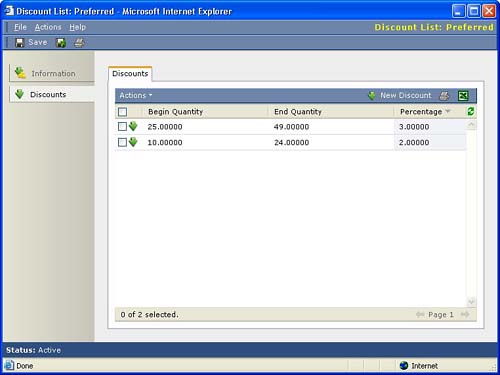
Discount Lists are associated with Price List Items, as shown in Figure 5.19. Price List Items are items (Products or Services) that have been added to a price list. Discount Lists are never required, but can be used in the case when you need to apply volume discounting on a certain item or items when a specific Price List is used.
Figure 5.19. Discount Lists can be associated with Products on a Price List.
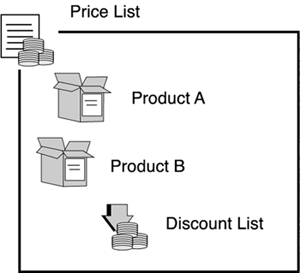
Unit Groups
Unit Groups are simply hierarchies of units of measure. For example, if you sell beer by the six pack, twelve pack, or the case, you would have a base unit of a single beer, and then a unit of measure called twelve pack, which would consist of twelve beers. You might also have a case unit of measure that would consist of 24 beers, or four six packs, depending on how you actually packaged the product. The combination of these four units of measure is the Unit Group. Each Product must have a Unit Group assigned so the system will know how to measure its quantity on Sales Opportunities, Quotes, Orders, and Invoices. See Figure 5.20.
Figure 5.20. Each Product must be assigned a Unit Group.
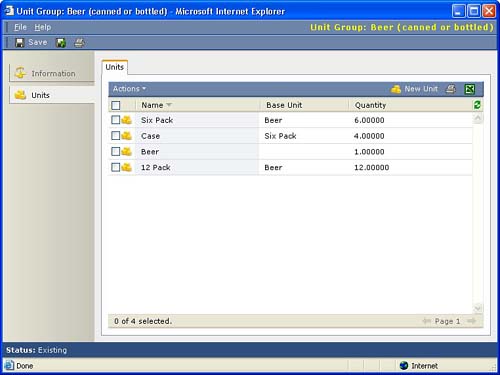
Price Lists
Price Lists are groups of Products with potentially different prices from the Product's list price. Price Lists give you the ability to create specialized pricing down to a very granular level. You can, if it makes sense, create price lists by customer. Or, if your prices don't vary, you can use one price list for all customers. Price Lists come into play when setting up Sales Opportunities, Quotes, Orders, or Invoices. Each of these must be assigned a Price List so that the system knows what to charge for the Products in question, as shown in Figure 5.21. In fact, you will not be allowed to add Products to a Sales Opportunity, Quote, Order, or Invoice if you have not assigned a Price List.
Figure 5.21. Opportunities, Quotes, Orders, and Invoices must be assigned a Price List.
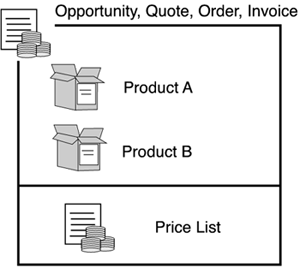
Products
Products are just what you'd expect. They are records that represent items you sell on a repetitive basis. The reason we say repetitive here is because Microsoft CRM also gives you the opportunity to create write in products on-the-fly as you create Quotes, Orders, and Invoices.
Write-in products are used to add products that do not need to be part of the master product catalog. However, here we will discuss the Products you set up in the Product Catalog. Let's start by navigating to the Settings tab—Product Catalog section, Products section and opening a Product record, as shown in Figure 5.22.
Figure 5.22. The Product Screen.

Notice that there are several tabs along the left navigation bar of the Products screen. You'll learn about these as we go through the rest of the book, but take a look at the Substitutes tab. This tab enables you to link (Append) existing product records to the current record so your users will be aware of products that can be considered as substitutes. This can be helpful for companies that sell various competing products or when there are products that will work in place of other products when product availability is an issue.
Setting up the Product List is straightforward, but you definitely want to consider the relationship between Subjects and Products. You normally don't need your Subjects to mirror your Products and most likely will want your Subjects to be at a higher level than the Products. Think of the Product record as being as specific as possible, so you will know which customers have which exact product models or versions. Your Subjects should be at a level sufficient to enable you to capture trends across sets of similar Products. An example of this is provided in Chapter 9, “Customer Service.”
Kit Products
Many companies sell combinations of their products as kits with special bundled pricing. Microsoft CRM supports this by letting you create a Product record and convert it to a kit. Enter a Product record normally, save it, and then use the Convert to Kit option on the Product's Actions menu to convert that Product to a Kit, as shown in Figure 5.23.
Figure 5.23. Converting a Product to a Kit.
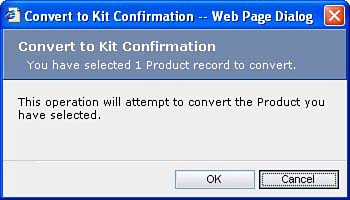
After the conversion selection has been accepted, a Kit screen replaces the Product screen. The Kit screen differs from the Product screen in that it enables you to associate multiple Product line items to each Kit. See Figure 5.24.
Figure 5.24. The Kit screen enables multiple products to be bundled together with a single price.
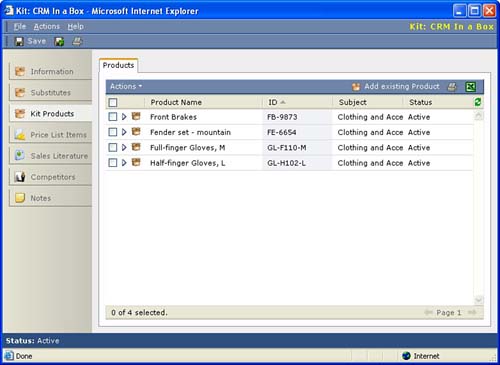
Each Kit record has a single price that represents the price of the entire kit.
